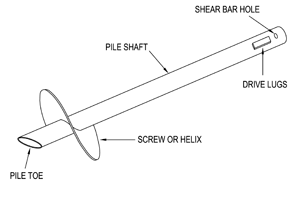Screw piles
Screw piles, sometimes referred to as screw anchors, screw-piles, helical piles, and helical anchors are a steel screw-in piling and ground anchoring system used for building deep foundations. Screw piles are manufactured using varying sizes of tubular hollow sections for the pile or anchors shaft.

The pile shaft transfers a structure's load into the pile. Helical steel plates are welded to the pile shaft in accordance with the intended ground conditions. Helices can be press-formed to a specified pitch or simply consist of flat plates welded at a specified pitch to the pile's shaft. The number of helices, their diameters and position on the pile shaft as well as steel plate thickness are all determined by a combination of:
- The combined structure design load requirement
- The geotechnical parameters
- Environmental corrosion parameters
- The minimum design life of the structure being supported or restrained.
Screw pile steel shaft sections are subjected to design parameters and building codes standards for the region of manufacture.
The helices are usually round in shape, can be prepared using metals or concrete, the helices that are welded over the steel shaft are also called flights or Helical Flights, helical flights can be of varying sizes depending upon the requirement of surface.
These helical flights are joined/welded through various technologies , one such technology is called inertia welding , strongest joints are made through inertia welding technology for helical piles , which allows it to bear maximum possible load for any types of foundation.
There are only a few differences between helical anchors, helical piles and helical piers but the terms are often used interchangeably.
Helical Anchors are an extendable method of a steel shaft wielded with helical bearing plates. Plies/Piers both refer to profound base elements that withstand or transfer vertical/horizontal loads. Anchors are piles utilized only in uplift/tension software like restraining wall tiebacks or vertical ground anchors made to resist overturning forces
Remember Tension forces are those that pull materials apart and Compression is the one that squeezes material together Piles are usually Composed of steel, wood, etc, can be small in diameter and also does not use concrete in their construction Piers are made up of concrete just and can be made in large diameter.
Helical anchors are employed in tension/uplift applications, can be set up vertically or horizontally. Horizontally, they frequently put behind retaining walls and called tiebacks, Vertically, they are known as anchor piles, base anchors, ground anchors, ground anchors or soil anchors
Installation
Screw piles are wound into the ground much like a screw into wood. Screw piles are installed using various earthmoving equipment fitted with rotary hydraulic attachments. Machinery varies from skid-steer loaders to 5 tonne through 80 tonne excavators. Rotary hydraulic powerheads with torque capacities ranging from 5,000 Nm to 500,000 Nm are custom fitted using various boom configurations. Special drive attachments connect the screw pile to the machine. Correct installation techniques are paramount to meet engineered design load and settlement outcomes. Incorrect techniques are likely to result in poor overall pile performance.
Development

Screw piles can be referred to as screw-piles, steel screw-in foundations, screw piers, helical piles, helical anchors, screw anchors, screw foundations and helical piers.[1] Screw piles were first described by the Irish civil engineer Alexander Mitchell in a paper in Civil Engineer's and Architects Journal in 1848 - however, helical piles had been used for almost a decade by this point.[2] Screw foundations first appeared in the 1800s as pile foundations for lighthouses,[3] and were extensively used for piers in harbours. Between the 1850s through 1890s, more than 100 screw-pile lighthouses were erected on the east coast of the United States using screw piles. Made originally from cast or wrought iron, they had limited bearing and tension capacities. Modern screw pile load capacities are in excess of 2,000 kN (220 short tons-force). Large load capacity screw piles may have various components such as flat half helices, Bisalloy cutting tips and helices, cap plates or re-bar interfaces for connection to various concrete or steel structures.
More recently, composite technology has been developed and patented for use in small screw piles. Composites offer significant advantages over steel in small screw pile manufacture and installed performance.
Screw pile design is based on standard structural and geotechnical principles. Screw pile designers typically use their own design software which has been developed through field testing of differing compression pile and tension anchor configurations in various soil profiles. Corrosion is addressed based on extended field trials, combined with worldwide databases on steel in ground corrosion.
Modern use and benefits
Screw pile foundations are still used extensively, and their usage has extended from lighthouses to rail, telecommunications, roads, and numerous other industries where fast installation is required, or building work takes place close to existing structures.
Most industries use screw pile foundations due to the cost efficiencies and - increasingly - the reduced environmental impact. 'Screwing' the foundations in the ground means that there is less soil displacement so excess soil does not need to be transported from the site, saving on transportation costs and reducing the carbon footprint of the project.
The main benefits of screw pile foundations include: shorter project times, ease of installation, ease of access, reduction of the carbon footprint, ease of removal when the foundations are no longer required, reduced risk to the workforce, and reduced costs.
They are also suitable for both tensile and compression loads, so they are also used for masts, signs, and retaining structures.
References
- "Helical Piles FAQ".
- Howard A. Perko Helical Piles: A Practical Guide to Design and Installation John Wiley and Sons, 2009 ISBN 0-470-40479-5 pages 3-11
- William John Macquorn Rankine A manual of civil engineering, C. Griffin, 1876 p. 605, p. 766
https://helicalanchorsinc.com/helical-faq/ for understanding the difference of helical anchor, helical pile and helical piers